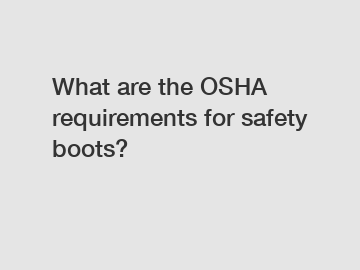What are the OSHA requirements for safety boots?
What are the OSHA Requirements for Safety Boots?
When it comes to workplace safety, the Occupational Safety and Health Administration (OSHA) plays a crucial role in setting regulations and requirements to protect workers. One area where OSHA has specific guidelines is the use of safety boots or footwear. In this article, we will explore what OSHA requires for safety boots and why they are important for ensuring workplace safety.
Importance of Safety Boots.

Safety boots are designed to protect workers from various hazards in the workplace, such as falling objects, punctures, electrical shocks, and slips or trips. They provide workers with essential protection, reducing the risk of foot and leg injuries that can result in lost productivity, medical expenses, or even disability.
H2: General OSHA Requirements.
OSHA requires employers to ensure that employees use appropriate protective footwear when working in hazardous environments. The general requirements for safety boots, as outlined by OSHA, include:
1. Impact Protection: Safety boots must provide protection against falling objects or other impacts that could cause foot injuries. They should have a toe cap that can withstand a certain level of force to shield the toes from crushing accidents.
2. Compression Protection: Along with impact protection, safety boots should have compression resistance. They should be able to absorb and distribute pressure in case heavy objects roll over the foot, preventing bone fractures or other injuries.
3. Electric Hazard Protection: OSHA recommends that safety boots provide electric shock protection for workers exposed to electrical hazards. These boots are designed to minimize the flow of electricity through the body, reducing the risk of electrical accidents.
4. Puncture Protection: Safety boots should have puncture-resistant soles to protect workers from sharp objects, such as nails or metal shards, that may be present on the floor or ground.
5. Slip Resistance: Employers need to ensure that safety boots have slip-resistant soles to prevent slips, trips, and falls. Boots with proper gripping capabilities provide stability and reduce the risk of accidents on slippery surfaces.
H2: Additional Requirements by Industry.
In addition to the general requirements, specific industries may have additional safety boot regulations. For example:
1. Construction Industry: OSHA requires safety boots with protective toe caps for construction workers to prevent foot injuries caused by falling objects or accidental impacts on construction sites.
2. Electrical Industry: Electricians and other professionals working with electricity must wear safety boots that are electrically conductive, minimizing the accumulation of static charges and reducing the risk of electrical accidents.
H2: Compliance and Enforcement.
OSHA is responsible for ensuring that employers comply with safety standards, including the use of proper safety boots. Inspections, both scheduled and unannounced, are conducted to assess compliance. Employers found in violation may face penalties, citations, or even temporary shutdowns until the necessary corrective measures are implemented.
Compliance with OSHA regulations benefits both employers and employees. Employers can avoid costly penalties, lawsuits, and damage to their reputation. Employees, on the other hand, can work with peace of mind, knowing that their employer values their safety and wellbeing.
In conclusion, wearing the appropriate safety boots is crucial to protect employees from workplace hazards and ensure their wellbeing. OSHA's requirements provide guidance to employers in selecting the right type of safety boots for their workforce. It is essential for employers to understand and comply with these regulations, as failure to do so can have serious consequences. If you have any further questions or need assistance with safety boot requirements, please do not hesitate to contact us.
Contact us to discuss your requirements of pvc safety rigger boots, wellington rubber PVC boots, Black Safety Rubber Shoes. Our experienced sales team can help you identify the options that best suit your needs.
162
0
0


Comments
All Comments (0)